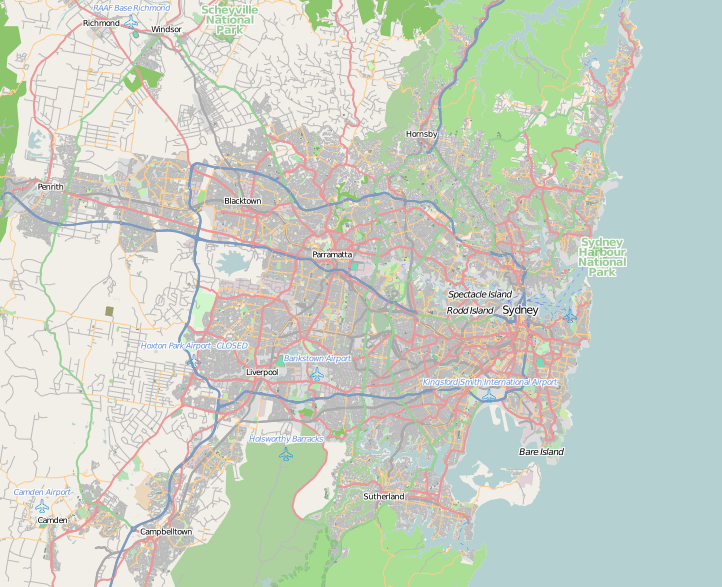Kailoa
Kailoa is a heritage-listed villa at 44 Union Street, North Sydney, North Sydney Council, New South Wales, Australia. It was added to the New South Wales State Heritage Register on 2 April 1999.[1]
| Kailoa | |
|---|---|
.jpg) | |
| Location | 44 Union Street, North Sydney, North Sydney Council, New South Wales, Australia |
| Coordinates | 33°50′29″S 151°12′10″E |
| Official name: Kailoa | |
| Type | State heritage (built) |
| Designated | 2 April 1999 |
| Reference no. | 179 |
| Type | Villa |
| Category | Residential buildings (private) |
 Location of Kailoa in Sydney | |
History
Description
- Garden
The 1985 garden still exhibits its early planning with many original trees surviving. There is a fine cast iron picket fence, on a stone foundation with impressive cast-rion entry gates. A curved entry driveway is planted with pygmy date palms (Phoenix roebelenii).[2][1]
Condition
As at 13 December 2004, in 1985 the item's condition was basically "derelict"; "poor condition particularly internally of the house, detracts from its significance the dilapidated condition and extensive reconstruction required, conservation should take place within a framework of adaptation to a compatible use as a means to generate the necessary funding. Several large trees have died The front garden still exhibits its early planning with many original trees survivingThe front fence and gates are in reasonable order ground levels around the rear of the house and heavy undergrowth are exacerbating the problems of rising damp in the adjacent rooms...[3][1]
Modifications and dates
Further information
The poor condition particularly internally of the house, detracts from its significance, which as a result, is derived largely from its surviving form and massing. Conservation is however desirable to retain its key place in the streetscape and recover its architectural character and detailing. Given the dilapidated condition and extensive reconstruction required, conservation should take place within a framework of adaptation to a compatible use as a means to generate the necessary funding.[1]
Strict reconstruction or reinstatement of original detailing is not necessary and may be impractical given the extent of demolition and possible lack of documentary evidence. Reconstruction shall however be in a form which respects and largely replicates the finishes and decorative elements which could have been expected in a house of this quality in the mid 1880s. Where physical evidence survives, renewed detailing should follow, as closely as practical, the original. New services should be discretely inserted.[1]
External works shall respect the character of the original landscaping, in particular the curving front entry and palm trees. Car parking shall be located at the side of the house, in a way which minimises the visual impact. The front fence and entry gates shall be retained or reused to suit new entry requirements.[1]
The most appropriate and compatible use for Kailoa would be one which retains the essential external formand intenral arrangement of spaces. Such uses could include residential, cultural or community uses, an art gallery or small scale commercial functions. The overall impact of such uses should minimise changes to the fabric and setting.[3][1]
Heritage listing
.jpg)
As at 13 December 2004, Kailoa forms an integral and important part of an area with a rich and varied collection of residential architecture, the adjacent streets being a rare survival of intact 19th century townscape in North Sydney. It is a good example of its type and has retained its garden setting, being a single storey free standing Victorian Italianate villa, (c. 1885) set well back from the street on a prominent hill to the rear in landscaped grounds with a fair number of mature trees and well maintained garden setting.[1]
It is of state historic and social significance for its associational values and representative aesthetic values of this type of place. It is of regional historic, social and associative aesthetic significance as a representative example of its period and type.[1]
The poor condition particularly internally of the house, detracts from its significance, which as a result, is derived largely from its surviving form and massing.(1985) [4][1]
Kailoa was listed on the New South Wales State Heritage Register on 2 April 1999.[1]
References
| Wikimedia Commons has media related to Kailoa. |
- "Kailoa". New South Wales State Heritage Register. Office of Environment and Heritage. H00179. Retrieved 1 June 2018.
- Brooks, 1985, added to by Read, S., 2004
- Brooks, 1985
- Brooks, 1985; Taylor Brammer, 2004 & Adameitis, 2004; abridged by S.Read, 2004
Bibliography
- Graham Brooks & Associates P/L (1985). Statement of Conservation Policy - Kialoa 44 Union Street North Sydney.
- John Adameitis P/L Architect (2004). Statement of Environmental Effects - proposed landscaping and external works to Kialoa, 44 Union St., McMahon's Point.
- Taylor Brammer Landscape Architects P/L (2004). Kialoa 44 Union St., Nth. Sydney Landscape Heritage Impact Statement.
Attribution
![]()